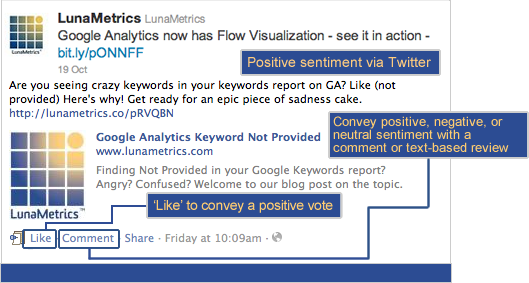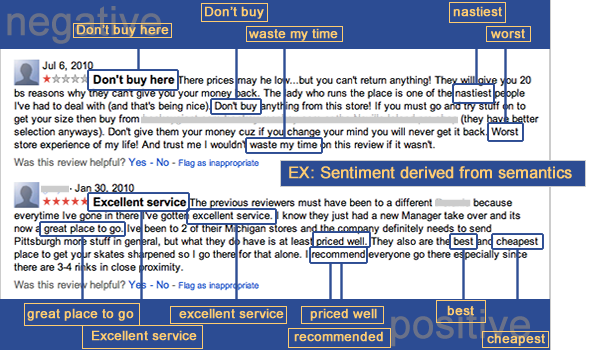Sentiment In Search ‑ Are All Votes Created Equal?
I think you’ll agree that an ever-changing search algorithm is dynamic in its engineers’ consistent efforts towards development, refinement, and ultimately, improvement. The end goal of any algorithm update, however large or small, is certainly not detraction from quality. In fact, it’s quite the opposite. An update is made, we can assume, to improve upon the quality of the results – no matter how insignificant-seeming the percentage of results affected. When I search “all about poodles,” I want to learn all about poodles – not play minesweeper with pop up and banner ads. Mind you, overall improvement does not necessarily translate to individual ranking increases; we know this all too well. With positive change comes almost certain hardship for those that are oppositely negative. Fortune favors the brave – yes. Similarly, though, misfortune handpicks the irresponsibly audacious. Just ask BMW or J.C. Penney – both of which have suffered the unrelenting punitive blows of Google’s “manual action.”
An algorithm update, in some sense, is the addition of an automation process to carry out an action that was previously executable only by handpicking or “manual action.” As you can imagine, penalizing (or rewarding) sites on a case to case basis is both laughably uneconomical and far too permissive of subjective, human analysis. It’s fairly intuitive, then, that the more frequently a particular rule needs applied, the more likely it is that that rule will become an integral part of the algorithm. For instance, when I search to learn more about our fluffy, white friends, the results at the top of the SERPs are largely informative and (more importantly) exactly what I’m looking for. Before Panda (which came with harsh penalties for websites with thin content), I might not have been so lucky. Anyways, that’s for another day. For now, we’ll focus on sentiment in search. Where is it going? Where has it been? And can its analysis be translated effectively and efficiently into the current search algorithm? Let’s have at it!
The Current State of Sentiment in Search
First off, let’s define the “sentiment” of an online vote (be it a link, review, service testimonial, etc.) as the connotation (positive, negative, or neutral) with which said vote is casted. While the link is traditionally recognized as the primary vote metric, developments in social technology and online listing review systems have broadened the user’s ability to convey relative, measurable sentiment within minutes (or even seconds). If you liked Christina’s recent blog post on ‘keyword not provided‘ or tweeted about Jim’s take on flow visualization in GA, you’ve engaged socially in conveying positive sentiment, or casting a positive vote for the respective post. On the other hand, if you found such disfavor in the stale-tasting coffee at the local donut shoppe that you felt obligated to share that negative experience with potential customers online (perhaps through a Google Places listing review), you’ve conveyed negative sentiment, or casted a negative vote for that business.

While we can’t be sure how these signals are weighted in the current algorithm, we can certainly infer that the integration process is well under way. With Google’s release of the +1 button and specific markup for reviews and rich snippets, it’s a reasonable assumption to make that the link is no longer the lone indicator of online sentiment. Notice, though, that the majority of these indicators are geared towards users sharing positive experiences (perhaps with exception to negative reviews). Although many custom blog platforms allow users to cast a negative vote for a given post with a thumbs-down, major social platforms (from which search engines actually collect data) like Facebook have yet to implement such an option. How, then, without clear-cut social signals, do we derive negative sentiment from a given comment or review? And perhaps more importantly, how do we go about deriving negative sentiment from the original vote metric – the link?
Sentiment Analysis – A Work in Progress
To preface this section, I’d like to recommend some light reading – a New York Times article (which Robbin suggested to me) that inspired this post (as it probably has many of the more recent debates on sentiment in search). The article details the much-chagrined success story (and subsequent fall) of an online eye glasses vendor who utilized the power of negative votes (provided by intentionally provoked customers) to leverage his company’s organic search presence. I’d like to spare you another poodle analogy, but honestly, I can’t resist. This should paint a fairly representative picture of the article (for those of you who are saving it for a rainy day).
If a fictitious John from John’s Poodle Emporium trains his dogs to be utterly disobedient to their renters, there’s a good chance that John’s business is going to receive plenty of negative reviews online. With no sentiment analysis, though, a review is a review and a link is a link. Online poodle forums and blogs are abuzz with horror stories about John’s Poodle Emporium (occasionally even linking to his site). Little do they know, they’re fueling the very fire that they seek to put out – sending link juice from relevant websites onto John’s site. John punks his Poodle-loving patrons and moves onto the next group of clients the town over (who haven’t bothered to check out some online reviews). All the while, his rankings are shooting through the roof, providing him with a healthy influx of new customers to mistreat intentionally.
Okay, back to reality. That was bad, but you get the idea. While Google affirms that the the real vendor’s rankings should be attributed to link juice from high authority news outlets (like the New York Times), citing the presence of the rel=”nofollow” link attribute on many of the negative review sites, the causation is there, nonetheless. Be it direct or indirect, in this case, negative sentiment yielded positive results.
How Do We Combat This?
Needless to say, the article prompted almost immediate action from Google. After doing their due diligence, they found that cases similar to that in the New York Times article were not as uncommon as they had originally thought. As we discussed earlier, a high volume of problematic, penalty-deserving websites can often complicate manual action. However, when all of these websites are linked by a common infraction, the likelihood that the penalties can be distributed algorithmically is much higher. In this case, the search engineers at Google were able to implement a quick, algorithm-intensive fix that penalizes online vendors who treat their customers poorly or unfairly. While we can’t be sure that this solution is completely free of sentiment consideration, we can be sure that sentiment analysis is not the foundation of the underlying framework. In fact, Google has admitted that although they have a “world-class sentiment analysis system,” they’ve yet to find a way to effectively implement that system within the current algorithm.
The Way of the Future?
It seems simple, doesn’t it? Just introduce an algorithm update that mandates that all crawls take into account the sentiment of the text surrounding a given link. If the connotation of the “context clues” is primarily positive, treat the link as a positive vote. If negative, weight the link with a negative value. Simple enough, right? Actually . . . not so much. We could pick the simplicity of this solution apart all day, so I’ll spare you the countless refutations in place of one (for which I’ll pose a rhetorical question). Aren’t some of the most important modern issues also the most polarizing issues? And, in our context, should a website pertaining to one of these issues be devalued because the negative sentiment nearly washes the positive? Hardly, in my opinion. A vote, whether positive or negative, is still an indication of care. As long as people care about a given issue or web page (and are willing to pay testament to their sentiments), as things stand, the results that they see will be based on sheer popularity.

With all that we’ve considered, many points remain mute. Incorporating user sentiment in search, whether socially, through review aggregators, or by sentiment analysis, is a tricky little game. Considering the tremendously impactful implications that a major sentiment-related algorithm change could have, it’s a game that needs to be played with the utmost tact and care. That said, I’m rather confident that user reviews, testimonials, social votes, context clues surrounding links, and even the sentiment of anchor text will continue to play larger roles in both organic and local rankings. Undoubtedly, the technology behind these metrics (and consequently, their popularity among users) will continue to develop in the future. This puts further onus on coinciding algorithmic development targeting search sentiment. Again, the end goal is better results for the user – or better information about poodles for curious dog lovers. If, by implementing a functional, discriminatory sentiment analysis system in the search algorithm, we’re able to achieve this, then I’m all for it. Personalized search is the way of the future. Sentiment analysis is just another step in the right direction . . . well, at least on the timeline.
What are your thoughts on sentiment in search? Are all votes created equal, or should positive and negative sentiment play a role in valuing a link? Have you observed any noticeable ranking changes since you’ve enabled social “voting” on your pages? Share your thoughts and experiences!